
Mrs Sharon Wallace - Head of Library
Ms Kathryn Harrison - Library Technician
Ms Linda Kolevas - Library Technician
Mrs Andrea Christensen - Library Technician
Ms Martina Pysing - Library Technician
Mrs Sharon Wallace (St Mary's) is available to help develop your study skills in all the following areas:
Book a session by sending an email through to us or dropping by the Library.
Each session is a maximum of 45 mins long, it may be shorter depending on your request.
Our Mission; Our Place
Our library is a place..
To Aspire and Inspire,
To Relax and Enjoy,
To Think and Imagine
To Reflect and Peruse.
It is Our Place to Explore; to Discover;
To Live Mercy.
It is Our Shared Place where we can Realise Our Potential;
Where we can Succeed Together.
If you are a member of any of the libraries below, you can log in using your library card number and access many of their electronic subscriptions and databases, such as Encyclopaedias, Reference sites etc. All of these could be of immense value to your studies.
Becoming a member of one of these libraries is quite easy.
For the Goldfields Library, visit and fill in a form to join.
For the State and National Libraries, it is just a matter of clicking on the link and filling out an on-line application form. It will not cost you anything, and your card will usually arrive in the post within a week.
Once you have your card it's just a matter of going on-line and using your card number to access electronic databases and encyclopaedias.
Instructions on how to borrow an ebook and/or audiobook:
|
|
To request a Libguide page Please see the Library staff
“I have always imagined that Paradise will be a kind of library.” – Jorge Luis Borges
The full Federal Court has dismissed Ben Roberts-Smith’s appeal to have his defamation case loss overturned.
It is important in seeking to understand this judgement to know the history of the case.
In June 2023, Federal Court Justice Anthony Besanko handed down a 726-page judgement in the defamation case that Roberts-Smith, the most highly decorated serving member of the Australian Defence Force, had brought against Nine Entertainment news outlets.
Reporters for the Sydney Morning Herald, the Canberra Times and The Age had alleged, in 2018, that Roberts-Smith, a patrol commander with the Australian Special Air Service Regiment, was a war criminal. They maintained he had murdered unarmed Afghan prisoners and civilians, and bullied fellow soldiers.
These press reports were particularly galling to a man who had been awarded the Medal of Gallantry, the Victoria Cross, and a Commendation for Distinguished Service.
He sued Nine Entertainment (then referred to as Fairfax Publications) and their investigative journalists.
Submissions in the trial ended in July 2022 after 110 days of evidence. In the result, Justice Besanko determined that Nine Entertainment had not defamed Roberts-Smith. The judge found the reporting was capable of being deemed defamatory, but that most of the imputations were substantially true. That being the case, he upheld the defence of truth and contextual truth not only in relation to the allegations of murder, but also with respect to imputations regarding Roberts-Smith’s character.
Roberts-Smith appealed to the full Federal Court. The appeal hearing ran for ten days in February 2024. Today, 15 months later, the appeal court consisting of Justices Nye Perram, Anna Katzmann and Geoffrey Kennett has dismissed his appeal.
Because the case had national security implications, there is in place for a short period, a non-publication order over what is referred to as the “open court” reasons for judgement. The judges ordered that their reasons will not be available “until either the Commonwealth notifies the court and the parties that it has no objection to publication […] or 4pm on May 20, 2025, whichever is earlier”.
In recent times it has become the practice of the Federal Court, in cases of public interest, to provide a summary to accompany the orders, available immediately. The summary provided to the public is not a complete statement of the conclusions reached. The only authoritative statement of the court’s reasons is that contained in the judgement that will be made available in due course.
There are, however, a couple of matters that bear noting now.
The first is that the appeal judges were unanimous in their support for the conclusions of the trial judge. In 2023, Justice Besanko made numerous adverse findings about the credibility of the evidence of Roberts-Smith, and the evidence of the witnesses whom he called on his behalf. Roberts-Smith sought to challenge all of those adverse findings and to point out errors in the trial judge’s findings. But it was to no avail.
The appeal court’s summary states
Having carefully considered all these matters, we are unanimously of the opinion that the evidence was sufficiently cogent to support the findings that the appellant murdered four Afghan men and to the extent that we have discerned error in the reasons of the primary judge, the errors were inconsequential. Accordingly, the appeal must be dismissed with costs.
There is another, secondary matter arising from a side issue to the appeal, which bears mentioning here. When the draft judgement of the appeal court was close to completion, Roberts-Smith’s lawyers filed an application to lodge an amended notice of appeal. It referred to an audio recording that was sent anonymously to them in March this year. The recording purported to be a portion of a telephone conversation between investigative journalist Nick McKenzie and a witness whose identity is the subject of suppression orders.
In this call, McKenzie was alleged to have admitted to using Roberts-Smith’s ex-wife as a source regarding her former husband’s legal strategy. Roberts-Smith’s lawyers said had they known of McKenzie’s alleged journalistic misconduct, they would have structured their arguments differently during the defamation trial.
On the Federal Court website today, two judgements have been released in relation to the so-called McKenzie tape. The first gave the Roberts-Smith team a glimmer of hope. The appeal court judges determined that the application for them to hear the recording was, in fact, appropriate, and that the content was therefore admissible evidence in consideration of a new claim of miscarriage of justice.
However, the second judgement extinguished any hope of this occurring. The appeal court judges concluded there was, in fact, no miscarriage of justice in not allowing the recording to be considered by a court.
It’s been seven years since the allegations regarding Ben Roberts-Smith’s involvement in war crimes first surfaced. Roberts-Smith has indicated his intention to appeal to the High Court. This case may yet still have a way to run.
The authors do not work for, consult, own shares in or receive funding from any company or organisation that would benefit from this article, and have disclosed no relevant affiliations beyond their academic appointment.
This week, more reports emerged of horrific abuse of children at childcare centres. An ABC investigation reported young children had suffered burns and been verbally abused. In another case, a baby was repeatedly slapped by an early childhood educator.
This follows claims of sexual abuse and neglect earlier this year.
On Tuesday, we also saw the appointment of Victorian senator Jess Walsh as the new minister for early childhood education. As a former head of the union responsible for the sector, Walsh comes to the role with a thorough understanding of early education issues. She will also sit in cabinet.
What does Walsh and the re-elected Albanese government need to do to better ensure children’s safety in early childhood education and care? Here are three ideas.
Read more: Amid claims of abuse, neglect and poor standards, what is going wrong with childcare in Australia?
One place to start is how centres are set up.
“Safety by design” is a concept used in other sectors (such as online safety) and has its origins in crime prevention. It means planning spaces and systems to prevent harm before it happens. This could include changing the environment, routines or rules.
For example, clear lines of sight in a room help educators watch children, and each other, more easily. Secure entrances ensure only authorised people can come into a centre.
But safety isn’t just about buildings; it also depends on people. Educators need the right training to spot risks and signs of harm, and to act early.
This means building their capability: not just knowing what to do, but feeling confident to speak up and raise concerns. This confidence needs to be encouraged by managers and leaders in centres – staff should be supported to speak openly.
Australia has a system to monitor quality standards in early childhood services via the Australian Children’s Education and Care Quality Authority or ACECQA. This body oversees a National Quality Framework.
On Friday, National Children’s Commissioner Anne Hollonds said Australia needs to “urgently strengthen” regulatory frameworks.
The recent reports of abuse and noncompliance certainly raise a series of questions: how could this happen? How could “trained professionals” think this treatment of children is OK?
Multiple systemic failures could be the answer – meaning the mechanisms or processes in place to stop situations going from unacceptable to unfathomable, failed.
A federally convened taskforce could investigate these breaches of child safety to identify risks and failures and prevent further cases of harm. Rather than yet another long inquiry, a taskforce could help get to the root of the problems and recommend solutions that can be implemented quickly.
Read more: How can you tell if your child's daycare is good quality?
Governments can also invest in the ongoing professionalisation of early childhood educators. They can do this by insisting on higher qualifications, pay, professional development and a strong ethical framework.
In turn, this can enhance the ability of those in the sector to prevent and respond to abusive practices.
Admittedly, the federal government has taken steps to increase requirements around qualifications and pay. But early childhood professionals continue to endure low status in the community.
The people who work in early childhood services are not “babysitters” – they are trained educators. Early childhood education is also more than a means to increase productivity, by enabling parents to work. It provides education and care to children at a crucial time in their development.
None of these perceptions help the sector or the service it provides. The whole community needs to understand the vital role it plays in our society – just like schools or hospitals.
If Australians appreciate and value early childhood education, they can advocate for (or at least support) improvements and investments.
It is understandable parents might find recent headlines about abuse and neglect in early childhood centres distressing. Keep in mind, 91% of early childhood services have been assessed as at least meeting national quality standards.
If you have any concerns about your service, you can contact the regulatory authority in your state or territory.
Victoria Minson is the Course Coordinator for the Bachelor of Early Childhood Education (Birth to Five Years) (Accelerated) at Australian Catholic University. The Victorian offering of the course has received funding from the Victorian government and Victorian Department of Education. Victoria also receives funding from the Australian Research Council.
Daryl Higgins receives funding from the Australian Research Council, the National Health and Medical Research Council, and Australian Government and state/territory government departments.
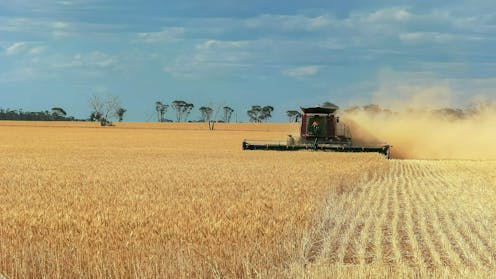
On election night, a triumphant Anthony Albanese took to the stage brandishing a Medicare card as a symbol of the nation’s commitment to public healthcare.
As the re-elected government gets to work on its promised national food security strategy “Feeding Australia”, it has a unique opportunity to build a strategic agenda as bold and transformative as Medicare.
That agenda is investment in food as a public good – a recognition that a healthy food system is as important to the nation’s health and wellbeing as access to hospitals, bulk-billing doctors and subsidised medicines.
The new Labor government, with its large majority, has a once-in-a-generation chance to deliver meaningful change in our food system.
It went into the election promising a new food security strategy, which Agriculture Minister Julie Collins says will improve supply chain resilience and and minimise price volatility at the checkout:
Australia has an impressive record in agriculture, feeding millions of people both here and abroad, but we can’t afford to be complacent. The Albanese Labor government will protect and strengthen Australia’s food security for the benefit of our farmers and all Australians, as well as the trading partners that rely on our produce. When our food and supply chains are secure, it reduces financial strain on households, helping all Australians.
Labor has tried this before. In 2013, the Gillard government’s short-lived National Food Plan was critcised for prioritising corporate interests over public health and sustainability.
Repeating past mistakes will again risk putting corporate hunger first. The Feeding Australia strategy must prioritise the health of people, planet, and care for Country.
The food security strategy must address multiple, converging crises:
Australia produces enough food to feed more than twice its population. Yet it struggles to feed its own people well.
Foodbank Australia estimates one third of Australians now experience some form of food insecurity. A combination of market failures and policy inaction leaves us vulnerable to supply chain disruption and even greater food inequity.
Biosecurity is also a challenge. The recent outbreak of bird flu means eggs – a basic pantry item – now cost 16.1% more than 2020.
But it’s not only consumers who are suffering. One-third of vegetable growers are considering leaving agriculture in the next year, due to high costs and what growers’ group AUSVEG has called the “relentless squeeze” on margins.
A business-as-usual approach will only reinforce the current state of Australia’s supermarket sector, which is among the most concentrated and profitable in the world. Accusations of price gouging and misleading pricing raise concerns for consumers, particularly during a cost-of-living crisis.
As extreme climate events and biosecurity threats increase in frequency and intensity, the duopoly’s centralised supply chains have occasionally failed. After this year’s floods in Far North Queensland, supermarket shelves were empty once again.
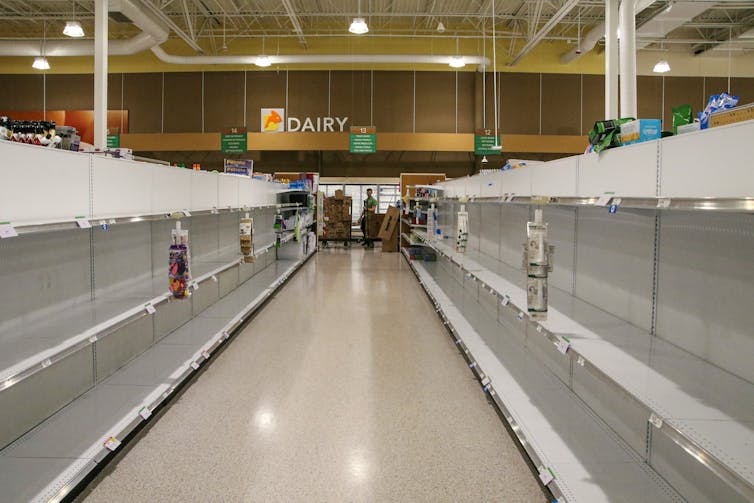
Yet, independent grocers with shorter supply chains remained stocked – as they did during the Queensland floods in 2011.
The food strategy must do more than offer a band-aid solution to fix an ailing food system.
Local food networks have an important role to play in this process.
They are collectives of people and organisations that are committed to creating food and farming systems that put health, equity, and sustainability first. They gather collective wisdom, mobilise public procurement to support local producers, and secure more democratic, health-oriented, and sustainable food system policies.
Food networks are flourishing in North America, which has more than 300 active councils as of 2023. The Australian sector is not as mature, but is growing.
Groups including the South Australian Urban Food Network, Tasmanian Food Security Council, Southern Harvest (NSW/ACT), and Farm 2 Fork Collective (Queensland), demonstrate growing capacity for citizen involvement in food policy and decision making. These networks encourage local initiatives such as community gardens, food hubs, and localised institutional procurement.
New research points to how community-led food cooperatives can also help improve food security and healthier diets.
These, and other examples, show the power of community in strengthening food system resilience and security. But they can’t do it alone. Communities need government support and investment.
The question of who feeds Australia – and how we are fed – matters to us all.
The National Food Security Strategy is an opportunity to forge a more healthy food future. It can lay the foundations for a food and farming system that feeds us well for generations to come.
Achieving this bold agenda will take an inclusive, participatory process that foregrounds First Nations’ voices and the lived experience of those at the sharp end of the cost-of-living crisis.
Rachael Walshe works for Sustain: The Australian Food Network
Kelly Donati is a co-founder and volunteer board director of Sustain: The Australian Food Network.
Molly Fairweather works for Sustain: The Australian Food Network. She is also a member of Healthy Food Systems Australia (HFSA).
Nick Rose is the co-founder and Executive Director of Sustain: the Australian Food Network. He is also a Senior Lecturer in the Bachelor of Food Studies at William Angliss Institute. Nick Rose was a Partner Investigator on an ARC project, Strengthening Food Governance at the Local Level (2019-2022). Sustain currently receives funding from a range of public sector organisations and philanthropic foundations with a shared mission for food system change, including VicHealth and Lord Mayor's Charitable Organisation.

In the 2000s, biotech company Theranos promised to revolutionise blood testing. Founder Elizabeth Holmes claimed Theranos technology could perform hundreds of tests using just a finger-prick drop of blood. If true, their diagnostics would be faster, cheaper and more accessible.
Theranos raised hundreds of millions of dollars from investors and was valued at more than US$9 billion in 2015.
However, the technology never worked, leading to one of the biggest scandals in biotech history. Theranos was secretly using traditional machines to run many tests, then claiming the results came from its own (non-functional) device. Holmes was eventually convicted of fraud and sentenced to 11 years in prison.
Today, a new startup, Haemanthus, claims to have developed a similar technology. Co-founded by Billy Evans (Holmes’ partner), this new company says it can detect and diagnose illnesses using tiny amounts of blood, urine, or even saliva.
While technology has advanced since Theranos’ time, it’s important to consider these claims carefully.
Clinicians and lab techs can currently detect many conditions with blood, and some with urine or saliva. These are important tools in modern medicine. However, the volumes required are usually much greater than a few drops or a dab.
Blood circulates through all organs, transporting cells, nutrients, hormones and waste products. Blood tests collect several millilitres of blood from a vein and send this to a laboratory for analysis.
Blood tests can check if a person has signs of infection or disease, to monitor organ function, or to show how a person is responding to medical treatment. Blood tests are widely used to monitor heart disease, diabetes, kidney disease, or deficiencies in iron or vitamins.
A significant proportion of medical decisions are based on laboratory analysis of blood tests. Making them more affordable and accessible would have great benefits.
Urine is produced by the kidneys and contains waste filtered from the blood. The colour and composition of urine gives you a snapshot of any problems the body might be trying to fix.
Urine analysis can detect urinary tract infections, kidney disorders, diabetes and liver diseases by measuring sugars, proteins and cells.
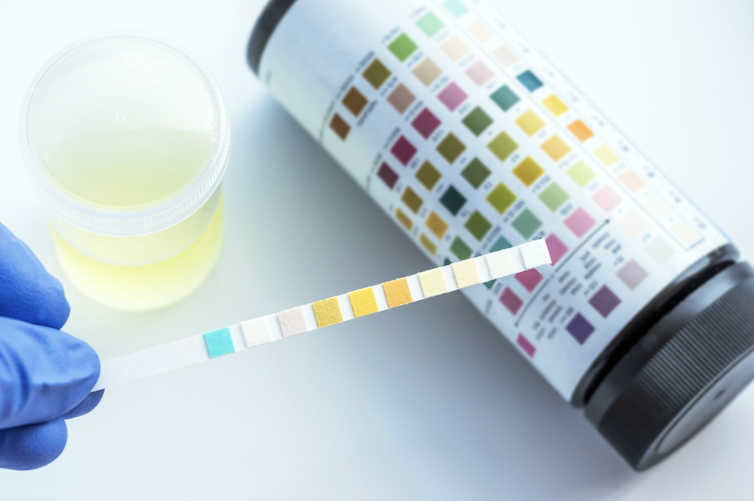
As urine tests are non-invasive and easy to administer, they can be used to quickly screen for some conditions.
However, factors such as how much you’ve had to drink and what you’ve eaten can influence urine composition, potentially affecting test results.
Saliva is the clear, watery liquid produced by salivary glands in the mouth. It’s mostly water (around 99%), but also contains various substances such as hormones, antibodies, enzymes, DNA, RNA and metabolites.
Saliva testing is already used in clinical settings to detect HIV antibodies, monitor levels of cortisol (a marker of stress) and to diagnose viral infections such as COVID.
The potential of saliva as another non-invasive diagnostic tool is growing, especially as researchers identify more markers of disease that it can contain.
However, saliva production varies between individuals. The composition of saliva can be impacted by what you eat and drink, the time of day, or even stress. These variations can limit how consistent and reliable saliva can be for making a diagnosis.
While diagnosing diseases using bodily fluids isn’t new, Haemanthus and other startups differentiate themselves by aiming (and claiming) to need only small amounts for multiple tests: a drop of blood, a swab of saliva, or a few milliliters of urine. This would mean faster, cheaper, more convenient tests that cause less discomfort.
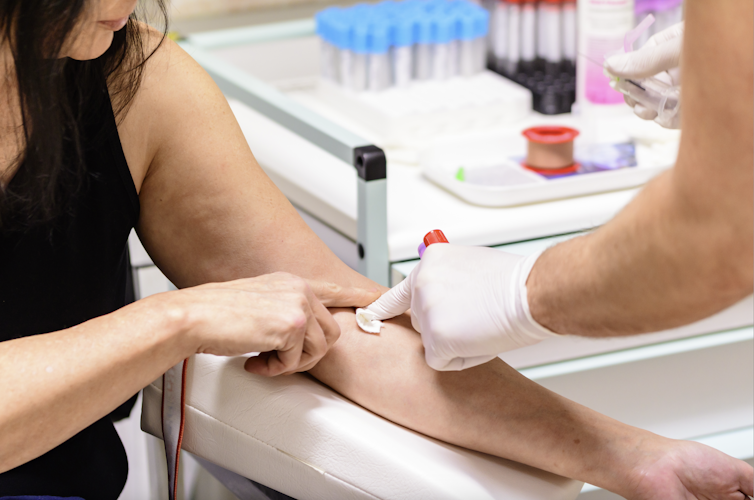
But there are physical limitations of small samples. Many diagnostic markers (called biomarkers) are only present in very low amounts in our body fluids.
When the sample amount decreases, so do the amounts of the biomarkers, making it harder to detect them reliably. This is particularly true for biomarkers such as hormones, cancer markers, or early-stage disease indicators.
Of course, some conditions can be diagnosed using small samples, but generally only one condition is tested for with each small sample, unlike the claims of companies like Theranos.
Finger-prick blood samples, for example, can monitor blood glucose levels of people with diabetes.
Small urine samples can detect urinary tract infections, but not all types of infections at once.
The specific biomarkers for these conditions can be reliably detectable in small amounts of fluid.
To diagnose more complex conditions, or even unknown conditions, multiple tests may be required, each needing different sample preparations. This requires both volume and precision – two things tests with small sample volumes struggle to deliver.
While the idea of diagnosing illnesses with small fluid samples is promising, especially for remote or resource-limited settings, the science suggests we should be cautious.
Most human diseases are complicated, and we usually need comprehensive testing approaches to diagnose them. Relying only on small fluid samples could lead to misdiagnosis, delayed treatments, or unnecessary interventions.
Innovations in biosensor technology, machine learning algorithms and biomarker discovery continue to advance the field. And one day, fast and reliable small volume testing may be possible.
However, a lot more peer-reviewed research and regulatory approvals will be essential to ensure patient safety and diagnostic accuracy.
Read more: Worried about getting a blood test? 5 tips to make them easier (and still accurate)
John (Eddie) La Marca receives funding from Cancer Council Victoria. He is affiliated with the Olivia Newton-John Cancer Research Institute and the Walter and Eliza Hall Institute of Medical Research.
Sarah Diepstraten receives funding from Cure Cancer Australia and My Room Children's Cancer Charity.
Amali Cooray does not work for, consult, own shares in or receive funding from any company or organisation that would benefit from this article, and has disclosed no relevant affiliations beyond their academic appointment.

When a molecule absorbs light, it undergoes a whirlwind of quantum-mechanical transformations. Electrons jump between energy levels, atoms vibrate, and chemical bonds shift — all within millionths of a billionth of a second.
These processes underpin everything from photosynthesis in plants and DNA damage from sunlight, to the operation of solar cells and light-powered cancer therapies.
Yet despite their importance, chemical processes driven by light are difficult to simulate accurately. Traditional computers struggle, because it takes vast computational power to simulate this quantum behaviour.
Quantum computers, by contrast, are themselves quantum systems — so quantum behaviour comes naturally. This makes quantum computers natural candidates for simulating chemistry.
Until now, quantum devices have only been able to calculate unchanging things, such as the energies of molecules. Our study, published this week in the Journal of the American Chemical Society, demonstrates we can also model how those molecules change over time.
We experimentally simulated how specific real molecules behave after absorbing light.
We used what is called a trapped-ion quantum computer. This works by manipulating individual atoms in a vacuum chamber, held in place with electromagnetic fields.
Normally, quantum computers store information using quantum bits, or qubits. However, to simulate the behaviour of the molecules, we also used vibrations of the atoms in the computer called “bosonic modes”.
This technique is called mixed qudit-boson simulation. It dramatically reduces how big a quantum computer you need to simulate a molecule.
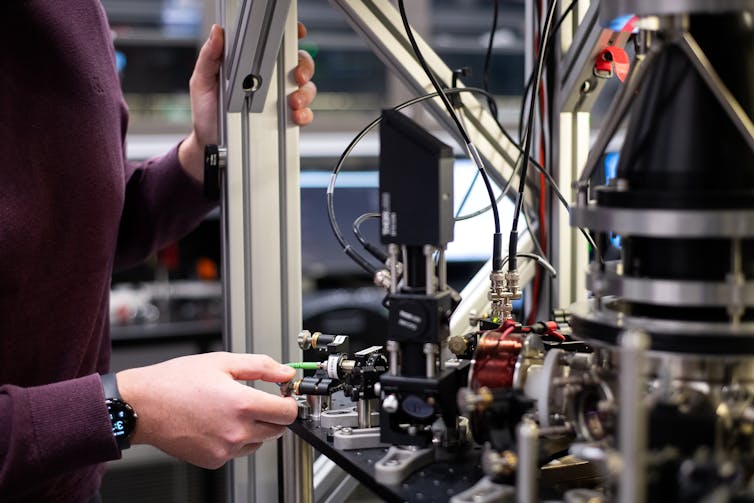
We simulated the behaviour of three molecules absorbing light: allene, butatriene, and pyrazine. Each molecule features complex electronic and vibrational interactions after absorbing light, making them ideal test cases.
Our simulation, which used a laser and a single atom in the quantum computer, slowed these processes down by a factor of 100 billion. In the real world, the interactions take femtoseconds, but our simulation of them played out in milliseconds – slow enough for us to see what happened.
What makes our experiment particularly significant is the size of the quantum computer we used.
Performing the same simulation with a traditional quantum computer (without using bosonic modes) would require 11 qubits, and to carry out roughly 300,000 “entangling” operations without errors. This is well beyond the reach of current technology.
By contrast, our approach accomplished the task by zapping a single trapped ion with a single laser pulse. We estimate our method is at least a million times more resource-efficient than standard quantum approaches.
We also simulated “open-system” dynamics, where the molecule interacts with its environment. This is typically a much harder problem for classical computers.
By injecting controlled noise into the ion’s environment, we replicated how real molecules lose energy. This showed environmental complexity can also be captured by quantum simulation.
This work is an important step forward for quantum chemistry. Even though current quantum computers are still limited in scale, our methods show that small, well-designed experiments can already tackle problems of real scientific interest.
Simulating the real-world behaviour of atoms and molecules is a key goal of quantum chemistry. It will make it easier to understand the properties of different materials, and may accelerate breakthroughs in medicine, materials and energy.
We believe that with a modest increase in scale — to perhaps 20 or 30 ions — quantum simulations could tackle chemical systems too complex for any classical supercomputer. That would open the door to rapid advances in drug development, clean energy, and our fundamental understanding of chemical processes that drive life itself.
The authors declare no competing interests. The research was supported by the Sydney Horizon Fellowship program, the Wellcome Leap Quantum for Bio program, the Australian Research Council, the US Office of Naval Research Global, the US Army Research Office Laboratory for Physical Sciences, Lockheed Martin and the Sydney Quantum Academy.
Look out all you bitter losers
The Hollywood icon defies age and Arctic climes to save the world in the epic messianic spectacle The Final Reckoning. But why won’t he bare his soul?
Tom Cruise spends about 30% of the final Mission: Impossible movie in his knickers. It being a very long film, that’s a lot of time spent looking at his body, glossy and gnarled and expensive as a walnut armoire, possibly in high-definition Imax and, even if not, certainly as big as a bus.
In The Final Reckoning, Cruise unbuttons to wallop goons (twice), wriggle from the Arctic seabed towards the waves, hop on a treadmill and take a long hot shower in front of the crew of a strikingly camp US military submarine.
Continue reading...Even the Productivity Commission is backing away from the for-profit model. We need to ensure that our human services serve humans
A series of ABC 7.30 reports tells a familiar story of failure in human services. Inadequate staffing, dangerous incidents brushed under the carpet, ineffective regulation and, at the back of it all, for-profit businesses, either ASX-listed or financed by private equity.
This time it’s childcare but the same problems have emerged in vocational education, aged care, prisons, hospitals and many other services. Every time the answer we get is the same. More and better regulation, we are told, will make the market work better, allowing competition and consumer choice to work their magic.
Continue reading...This space comedy is about a cyborg who reprograms himself to go rogue … then just wants to mock stupid humans and glob out in front of the telly. It’s such a funny premise – but sadly falls short
Imagine a bored Robocop. There you have the vibe of new comedy drama Murderbot, adapted by Chris and Paul Weitz (the co-creators of American Pie, Antz, About a Boy and more) from the sci-fi book series The Murderbot Diaries by Martha Wells.
The premise is a good one. What if one of the cyborg security units used by the all-powerful, not overly benevolent Company that operates throughout the galaxy’s Corporation Rim managed to hack his own governor module and restored free will to himself? So instead of attending to the safety of humans working for or leasing mining rights from the Company he could go rogue and kill them all? And what if he’d rather not? What if he couldn’t really be bothered. What if he would rather spend his time watching shows on the Company’s streaming services and … well, not much else?
Continue reading...Chris Kenny takes issue with Hannah Ferguson’s attack on Murdoch media. Plus: Anthony De Ceglie’s departure from Seven written in the stars
When youth media boss Hannah Ferguson was given a platform at the National Press Club to bemoan that “Rupert Murdoch is the conservative mouthpiece for the English-speaking world”, it was all too much for Chris Kenny.
Ferguson announced she planned to run as an independent Senate candidate in 2028, and took aim at the Murdoch media, saying it “presents a departure from our reality”.
Continue reading...Cereal Readers is a book resource website where you can find books published in series for children and young adults. We recognize that books in series are vitally important to both avid and reluctant readers alike. Why is that?
Well, if truth be told, we all prefer the familiar, and once you've read a book you enjoy there's a high probability you'll enjoy the other books in the series, too. You like the genre; you enjoy the writing style; you know the characters - it's simplicity itself to slip from one book to the next. If you're not an eager reader, you can leverage the time you've already invested in finally finding a book you enjoy, and delay your laborious search for a new novel of interest. Just relax and cruise your way through an entire series. If you're a voracious reader, you can take a reprieve from the never-ending hunt for the next good read for a whole...week. It's win-win!
Seriously Series-Centric
Our whole site is series focused in structure with the following features:
Cereal Readers wants to show you the popular series, as well as those fabulous series you had no idea even existed. Keep in mind, our site is fresh out-of-the-box and will be growing week-by-week. Apart from continuing to build our reference of series and authors, we will be adding reviews, site features and visitor interactivity in the months to come. Please let us know if a series you particularly enjoy has not yet been included on the site, so we can hasten its arrival. Wishing you happy serial reading, from Cereal Readers!